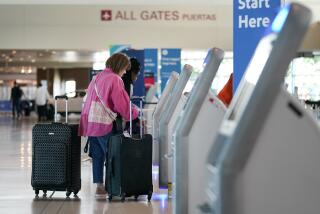Free Flight or Free-for-All?
- Share via
The Federal Aviation Administration is floating a revolutionary proposal known as “free flight” that would shift responsibility for routing planes from air traffic controllers to pilots. The plan hinges on the government’s ability to speed up acquisition of state-of-the-art technology and prove to critics that free flight wouldn’t lead to a free-for-all that could compromise safety. In that respect the FAA could be in for a bumpy flight.
Under the traditional setup, planes fly one behind the other, along fixed “highways” in the sky. When a pilot wants to make a detour, say to avoid bad weather or make up for lost time, the change must first be cleared by ground controllers.
With free flight, pilots would, in effect, become controllers themselves. They and their crews would be allowed to choose the quickest or safest route with help of global positioning satellites. To avoid problems in crowded airspace, planes would be outfitted with improved on-board computers, collision avoidance systems, weather radar and air-to-ground data links. Controllers would still provide guidance for takeoffs, landings, ascents and descents.
With a doubling of air traffic predicted over the next 10 years, FAA officials say that free flight would ease overcrowding and reduce delays. Airlines could save hundreds of millions of dollars in fuel costs and reduce inconvenience to air travelers. Of course, the No. 1 priority for any new system is that it ensure safety.
While almost everyone associated with commercial aviation agrees that the FAA must quickly upgrade its aging air traffic control system, a number of pilots, air traffic controllers and federal officials privately express concern about the free-flight plan. Before the FAA embarks on an overhaul it must answer some basic questions. What are the optimal stages for plan implementation? How would free flight relate to various aspects of air traffic control? Would the new responsibility overburden pilots? Who’s in charge when too many planes enter the same airspace?
Another looming issue is the FAA’s notoriously slow procurement procedures, which failed to deliver a major technology upgrade promised for the late 1980s. A further complication is the debate about whether to spin off the air traffic function as a quasi-public agency, privatize it altogether or make the FAA a separate government agency independent of the Department of Transportation.
The FAA already has taken small steps toward free flight by reducing routing restrictions for aircraft flying above 39,000 feet. But in terms of a more comprehensive transition in the rules of the skies, altitude is less important than distance. The proposal has a long way to go.
More to Read
Inside the business of entertainment
The Wide Shot brings you news, analysis and insights on everything from streaming wars to production — and what it all means for the future.
You may occasionally receive promotional content from the Los Angeles Times.










